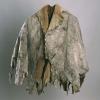Skin Cloaks Quilts
Kangaroo skin cloak of seven gores is made from the skins of seven grey kangaroos (Macropus fuliginosus). The skins vary in size and shape, the inner five are roughly triangular. The cloak is edged with a series of loops, through one of these near the collar is a piece of cloth which appears to have tied the cloak together. The skins are sewn together with two sorts of linen or cotton thread. In a small diamond-shaped gusset at the back of the neck there are some stitches of sinew. The skins are sewn together by means of a small hem which was turned back on to the fur, so stitches went through two layers of skin on each gore. There are some small holes in the skins. The skins are very soft and pliable, and greyish in colour; they vary in size and shape.
Longest part: 800mm
Ref: MA Thesis 1973, S.Meagher 'A Reconstruction of the Traditional Life of the Aborigines of the S.W. of Western Australia.
Skin rug of kangaroo or wallaby skins. Rectangular pieces stitched together.
Possum skin cloak. Possum skins sewn together with vegetable fibre or kangaroo sinew. Designs incised into the skins, some of which are decorated with ochres.
2070 x 1540mm
3 fragments of koala bear skin joined with very fine stitching. Uneven edges. Thought to have been part of an aboriginal cloak or rug.
Wallaby skin rug of small rectangles stitched together with sinew. The back of the rug has been scored in diamond patterns.
Rabbit Skin Cloak. Rectangular pieces stitched together with sinew and later repaired with fishing line.
Traditional Aboriginal fur cloak called a 'Buka' or 'Boka', made with three pieces of pelt. Fastened at the front with a piece of fur inserted into the other side.
1500 from back of neck to hem
1600 measuring around to just below the shoulders
Kangaroo skin cloak of seven gores is made from the skins of eight grey kangaroos (Macropus fuliginosus). The skins vary in size and shape, the inner five are roughly triangular. The extra skin has been used to make a collar.The two skins on the edge of the cloak are roughly rectangular. The cloak edges are untrimmed.
The skins are sewn together by means of a small hem which was turned back on to the fur, so stitches went through two layers of skin on each gore. The skins have been sewn together with thread, the older thread is natural coloured linen, then the resewn areas have been stitched with black thread. The skins are a creamy yellow in colour.
Longest part: 750mm approx.
[From S. Meagher MA Thesis 1973 'A Reconstruction of the Traditional Life of the Aborigines in the SW of Western Australia']
Possum skin cloak. The possum skins are sewn together with vegetable fibre or kangaroo sinew. Designs are incised into the skins, some of which are decorated with ochres.
2720 x 2100mm






